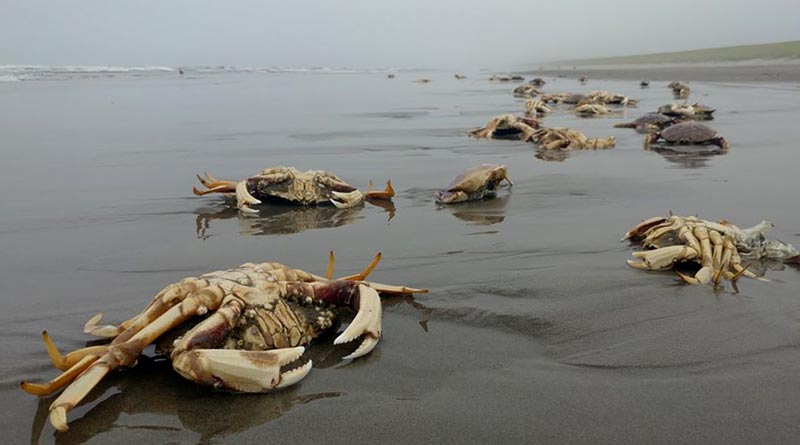Another Oregon / Washington Coast Oddity: Bundles of Crab Shells on Beaches
Published 06/25/21 at 2:15 AM PDT
By Oregon Coast Beach Connection staff

(Oregon Coast) – Like clockwork they show up this time of year on the Oregon and Washington coastlines: bunches of crab shells that look like some massive die-off. You'll even see the legs and other parts appearing to be intact. It often alarms visitors, but it's a harmless natural event. In fact, it's good for the crabs. (Photos courtesy Seaside Aquarium)
Includes exclusive listings; some specials in winter
In Cannon Beach:
Includes rentals not listed anywhere else
In Manzanita, Wheeler, Rockaway Beach:
Some specials for winter
In Pacific City, Oceanside:
Some specials for winter
In Lincoln City:
Some specials for winter
In Depoe Bay, Gleneden Beach:
Some specials for winter
In Newport:
Look for some specials
In Waldport
Some specials for winter
In Yachats, Florence
Some specials for winter
Southern Oregon Coast Hotels / Lodgings
Reedsport to Brookings, places to stay; winter deals
Those crabs are not deceased – they've simply left the building. Their shells are empty because it's molting season for the female Dungeness crab. Late in the summer you'll see it again but at that time it's the male Dungeness that vacate their premises. In August, you'll see even more of them.
Science calls it crab exuvia, according to Oregon Department of Fish and Wildlife (ODFW). Essentially, they've shed their shells and are getting ready to grow new ones.
“It can look like a major disaster occurred to the crab population, but it's as natural as kids outgrowing their old shoes,” ODFW said.
Tiffany Boothe of Seaside Aquarium deals with this each time, explaining it to visitors and educating on social media. She said this does not happen onshore, on the beach. Instead, they wriggle out of their shells out there in the deep.
“Discarded crab shells settle on the ocean floor until strong currents wash them ashore,” she said. “Molted crab shells have all the external parts intact - including legs, antennae, eyes, and gill supports, which makes it difficult to tell whether or not you are looking at a dead crab or just a molt.”

Though it's the Dungeness crab, before you start drooling over the idea of a free dinner scooped up off the beach, you won't find any meat in there. This is simply the exoskeleton parts and the shells.
Boothe said the crab’s new shell is soft and flexible. All this time it’s been developing while the crab was fasting before this point.
“The crab expands its new shell by filling its body cavity with water,” she said. “During this time, the crab is extremely vulnerable to predators and will bury itself in the sand to avoid detection. Once the crab’s shell starts to harden (which can take several days), the crab will resume feeding. Soon the crab will consume enough food to restore its fat reserves and replace the excess water in its shell with muscle. Then the cycle starts all over again.”

Reports have been popping up all over the Oregon coast, from the southern areas down around Bandon or Nesika up to Manzanita and beyond. These finds are currently accompanied by other sightings of a particular kind of salp that has visitors puzzled right now, as well as egg casings from squids, which show up as clusters of white tubes.
West winds always blow the largest number of things onto beaches, but there's likely not a lot of those winds now with the upcoming heatwave or the valley would be a little cooler.
Oregon Coast Hotels for this event - South Coast Hotels - Where to eat - Maps - Virtual Tours
Cannon Beach Lodging
Nehalem Bay Lodgings
Manzanita Hotels, Lodging
Three Capes Lodging
Pacific City Hotels, Lodging
Lincoln City Lodging
Depoe Bay Lodging
Newport Lodging
Waldport Lodging
Yachats Lodging
Oregon Coast Vacation Rentals
Oregon Coast Lodging Specials


More About Oregon Coast hotels, lodging.....
More About Oregon Coast Restaurants, Dining.....
LATEST Related Oregon Coast Articles
Through 2 a.m. likely best, but some lights possible through dawn June 1 - 2. Space weather, astronomy
Rare Sperm Whale Stranding on N. Oregon Coast, Was Hit by Boat
Showing up near Gearhart, it will decompose naturally. Marine sciences
Coast Guard Barque 'America's Tall Ship' Coming to Portland Rose Fest, N. Ore...
Portland events: June 5 - 8; Astoria events June 13 - 15. Weather
Bright and Active Arietids Meteors May Hit Pre-Dawn Hours of Oregon, Washingt...
Look to east hour before sunrise and you may catch a show. Sciences, astronomy, weather
Why Now Could Be a Great Week for Spotting Killer Whales on Oregon Coast - Video
A good dozen documentations around Depoe Bay, Newport, Coos Bay, Bandon, Tillamook. Marine sciences
Summer Road Work, Traffic Issues Along Oregon Coast Include Astoria, Garibald...
Some daylight closures include bridges, OR 22, OR 18, OR 26, more. Travel tips. Seaside, Cannon Beach, Lincoln City. Travel tips
Pacific City Oregon Weather, 7-Day Forecasts, Live Conditions, Radar, Webcams...
Updated Constantly: Pacific City, Tierra Del Mar, Oregon Weather, Cams, Buoy Observations, Tides, Warnings - Alerts
Oregon Coast Has World's Oldest Harbor Seal, Celebrating 50 Years Soon
June 3 at Oregon Coast Aquarium in Newport. Newport events
Back to Oregon Coast
Contact Advertise on BeachConnection.net
All Content, unless otherwise attributed, copyright BeachConnection.net Unauthorized use or publication is not permitted



















































